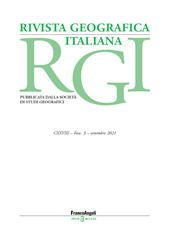2021 - Franco Angeli
Article
Digital Version
Public time-space, Interstices, Intersections and Traces-as-remains : possible Chronotopes of the European District in Brussels
5-35 p.
- The most common image of the European Quarter of Brussels is built on the idea of a clean, free, safe and controlled space that attracts people with high economic, social and cultural capital, and a growing number of "passing" users (tourists or consumers). Against this background, our research aimed to investigate the nexus between the material, symbolic, normative and discursive construction of the EU district timespace, on one hand, and everyday life, on the other. To do so, we explored the potential of a rhythmic and nonrepresentational approach in deconstructing dominant sociospatialtemporal representations, scraping off the layers of the commonlyknown to unveil alternative chronotopes. In this article, we present and discuss a reinterpretation of our experience and discuss the results of our analysis through four chronotopes linked to the spatiotemporal rhythms we observed, rhythms we have called Public timespace, Interstices, Intersections and Tracesasremains. [Publisher's text].
- The most common image of the European Quarter of Brussels is built on the idea of a clean, free, safe and controlled space that attracts people with high economic, social and cultural capital, and a growing number of "passing" users (tourists or consumers). Against this background, our research aimed to investigate the nexus between the material, symbolic, normative and discursive construction of the EU district timespace, on one hand, and everyday life, on the other. To do so, we explored the potential of a rhythmic and nonrepresentational approach in deconstructing dominant sociospatialtemporal representations, scraping off the layers of the commonlyknown to unveil alternative chronotopes. In this article, we present and discuss a reinterpretation of our experience and discuss the results of our analysis through four chronotopes linked to the spatiotemporal rhythms we observed,rhythms we have called Public timespace, Interstices, Intersections and Tracesasremains. [Publisher's text].
-
Information
DOI: 10.3280/rgioa3-2021oa12524
ISSN: 0035-6697
KEYWORDS
- cronotopi, ritmanalisi, geografie nonrappresentazionali, Quartiere Europeo Bruxelles
- chronotopes, rhythmanalysis, nonrepresentational geographies, European DistrictBrussels
-
In this issue
- Public time-space, Interstices, Intersections and Traces-as-remains : possible Chronotopes of the European District in Brussels
- La didattica a distanza nell'Italia diseguale : criticità e differenze territoriali durante la prima ondata Covid
- Tourism Peaks on the Three Peaks : using big data to monitor where, when and how many visitors impact the Dolomites UNESCO World Heritage Site
- Il patrimonio bio-culturale alpino : un approccio geografico-storico al pascolo alberato di larici in Trentino (XVIII-XXI sec.)
- Come organizzare le comunità energetiche? : un' ipotesi di prospettiva metodologica osservando due casi studio
- Cooperazione agricola Cina-Tanzania : innovazione o dipendenza?
- In attesa dei risultati dell'ultimo Censimento generale dell'agricoltura : come utilizzare i dati aderendo alla realtà territoriale
- Informazione bibliografica


